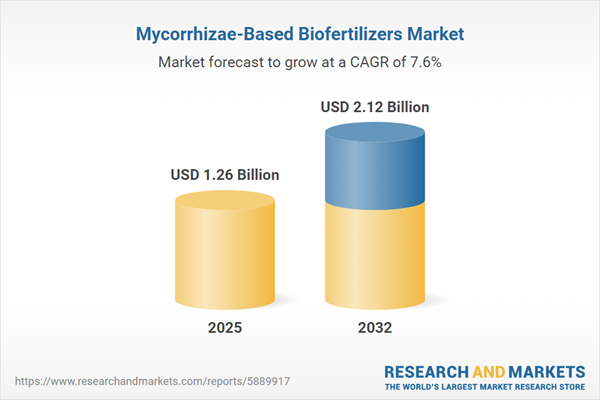Speak directly to the analyst to clarify any post sales queries you may have.
The mycorrhizae-based biofertilizers market is transforming agricultural inputs by enabling sustainable plant nutrition and improved soil health. As producers and policymakers seek alternatives to conventional agrochemicals, biofertilizers based on mycorrhizal fungi are emerging as pivotal tools for environmentally responsible crop management. This report equips industry leaders with actionable insights for strategy development and competitive positioning.
Market Snapshot: Mycorrhizae-Based Biofertilizers Market Growth
The Mycorrhizae-Based Biofertilizers Market grew from USD 1.18 billion in 2024 to USD 1.26 billion in 2025. It is expected to continue growing at a CAGR of 7.60%, reaching USD 2.12 billion by 2032. Rapid adoption is driven by demand for enhanced nutrient efficiency, regulatory support for bio-based solutions, and advances in microbial biotechnology. Globally, improved access to high-quality inoculants and more sophisticated distribution platforms are fueling uptake across traditional and high-value crops.
Scope & Segmentation: Mapping Opportunities and Regional Dynamics
- Product Types: Arbuscular Mycorrhizae; Ectomycorrhizal Biofertilizers; Endomycorrhizal Biofertilizers; Ericoid Mycorrhizae; Orchid Mycorrhizae.
- Crop Types: Cereal and Grains (Corn, Rice, Wheat); Fruits and Vegetables (Apples, Grapes, Tomatoes); Oilseeds and Pulses (Soybean, Sunflowers); Ornamentals.
- Formulation Types: Liquid Formulations; Solid Formulations (Granular, Powder).
- Application Methods: Foliar Spray; Root Dipping; Seed Treatment; Soil Treatment.
- Distribution Channels: Agricultural Stores; B2B Online Channels; B2C Online Channels; Specialty Retailers.
- Application Areas: Biological Control; Nutrient Solubilization (Phosphorus, Zinc); Plant Growth Promotion; Soil Improvement.
- Target User Profiles: Agricultural Institutes; Commercial Farming Enterprises; Smallholder Farmers.
- End Use Industries: Agriculture (Conventional & Organic); Forestry; Horticulture (Indoor Gardening, Orchards); Research and Development.
- Regional Focus: Americas (United States, Canada, Mexico, Brazil, Argentina, Chile, Colombia, Peru); Europe, Middle East & Africa (United Kingdom, Germany, France, Russia, Italy, Spain, Netherlands, Sweden, Poland, Switzerland, UAE, Saudi Arabia, Qatar, Turkey, Israel, South Africa, Nigeria, Egypt, Kenya); Asia-Pacific (China, India, Japan, Australia, South Korea, Indonesia, Thailand, Malaysia, Singapore, Taiwan).
- Key Companies: AgriLife (India) Pvt Ltd; Agrotecnologias Naturales SL; Asfertglobal Lda.; Bayer AG; Biostadt India Limited; Corteva Agriscience; Farmadil India LLP; FMC Corporation; Groundwork BioAg Ltd.; Gujarat State Fertilizers & Chemicals Ltd.; Helena Agri-Enterprises LLC; Indogulf BioAg LLC; IPL Biologicals Limited; JH Biotech Inc.; Koppert; Lallemand Inc.; Neologie Bio Innovations I Private Limited; Novozymes A/S; Peptech Biosciences Ltd.; Phms Technocare Private Limited; Plant Health Care PLC; Privi Life Sciences Pvt Ltd; Real IPM Co.(Kenya) Ltd; T.Stanes and Company Limited; UPL Ltd.; Valent BioSciences Corporation.
Key Takeaways for Senior Decision-Makers
- Growing regulatory focus on reducing synthetic agrochemical usage is prompting producers to consider mycorrhizae-based solutions for compliance and sustainability goals.
- Advancements in microbial biotechnology and formulation science are enabling tailored inoculant solutions for different soil profiles, increasing effectiveness and user confidence.
- Digital integration in agronomy is streamlining adoption by providing precise application recommendations, which supports larger-scale and high-value crop operations.
- Diversification of application methods and product types is supporting penetration into new markets, including ornamentals and specialty horticulture where quality and resilience are crucial.
- Collaborations among bioproduct developers, distributors, and research institutions are accelerating innovation and improving supply chain efficiency amid market and regulatory shifts.
- Regional policy incentives and infrastructure investments have differentiated adoption rates, underlining the importance of localization in go-to-market strategies.
Tariff Impact: Adjusting to U.S. Trade Policy Changes
Recently imposed United States tariffs on selected microbial biofertilizer components are affecting both importers and domestic producers. Companies importing specialized strains and carrier materials are exploring alternative sourcing and local production, while U.S.-based manufacturers are investing in capacity and quality assurance to respond to heightened demand. Supply chains are being optimized as stakeholders navigate lead time adjustments and cost structure changes. Over time, localization may offer greater supply stability for North American stakeholders.
Methodology & Data Sources
Research combines secondary analysis of peer-reviewed journals, patents, industry publications, and policy documents with primary interviews of growers, executives, and scientific experts. Quantitative survey data informs market preferences and challenges. Results are validated through data triangulation and peer review by subject matter authorities.
Why This Report Matters
- Enables data-driven strategic planning for innovation, procurement, and expansion in a growing input market.
- Clarifies policy, technology, and regional variables shaping adoption pathways for mycorrhizal biofertilizers.
- Supports risk management and supply chain resilience efforts amid evolving regulatory and trade environments.
Conclusion
Mycorrhizae-based biofertilizers are shaping the future of sustainable agriculture by bridging scientific innovation and practical deployment. Strategic action, informed by regional and technical insights, will define long-term leadership and market success.
Additional Product Information:
- Purchase of this report includes 1 year online access with quarterly updates.
- This report can be updated on request. Please contact our Customer Experience team using the Ask a Question widget on our website.
Table of Contents
3. Executive Summary
4. Market Overview
7. Cumulative Impact of Artificial Intelligence 2025
Companies Mentioned
The companies profiled in this Mycorrhizae-Based Biofertilizers market report include:- AgriLife (India) Pvt Ltd
- Agrotecnologias Naturales, SL
- Asfertglobal, Lda.
- Bayer AG
- Biostadt India Limited
- Corteva Agriscience
- Farmadil India LLP
- FMC Corporation
- Groundwork BioAg Ltd.
- Gujarat State Fertilizers & Chemicals Ltd.
- Helena Agri-Enterprises, LLC
- Indogulf BioAg LLC
- IPL Biologicals Limited
- JH Biotech, Inc.
- Koppert
- Lallemand Inc.
- Neologie Bio Innovations I Private Limited
- Novozymes A/S
- Peptech Biosciences Ltd.
- Phms Technocare Private Limited
- Plant Health Care PLC
- Privi Life Sciences Pvt Ltd
- Real IPM Co.(Kenya) Ltd
- T.Stanes and Company Limited
- UPL Ltd.
- Valent BioSciences Corporation
Table Information
| Report Attribute | Details |
|---|---|
| No. of Pages | 183 |
| Published | November 2025 |
| Forecast Period | 2025 - 2032 |
| Estimated Market Value ( USD | $ 1.26 Billion |
| Forecasted Market Value ( USD | $ 2.12 Billion |
| Compound Annual Growth Rate | 7.6% |
| Regions Covered | Global |
| No. of Companies Mentioned | 27 |









